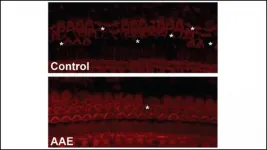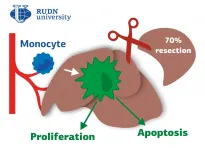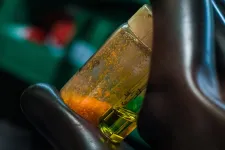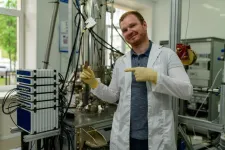Universal mechanism of regulation in plant cells discovered
In pioneering work, a German-Japanese research team at BESSY II has been able to determine the 3D structure of a metalloprotein that plays an important role as a catalyst in all plant cells
2021-06-21
(Press-News.org) All plant cells obtain their energy mainly from two organelles they contain - chloroplasts (responsible for photosynthesis) and mitochondria (responsible for the biochemical cycle of respiration that converts sugars into energy). However, a large number of a plant cell's genes in its mitochondria and chloroplasts can develop defects, jeopardising their function. Nevertheless, plant cells evolved an amazing tool called the RNA editosome (a large protein complex) to repair these kinds of errors. It can modify defective messenger RNA that result from defective DNA by transforming (deamination) of certain mRNA nucleotides.
Automatic error correction in plant cells
Automatic error correction in plants was discovered about 30 years ago by a team headed by plant physiologist Axel Brennicke and two other groups simultaneously. This mechanism converts certain cytidine nucleotides in the messenger RNA into uridine in order to correct errors in the chloroplast DNA or mitochondrial DNA. RNA editing is therefore essential to processes such as photosynthesis and cellular respiration in plants. Years later, further studies showed that a group of proteins referred to as PPR proteins with DYW domains play a central role in plant RNA editing. These PPR proteins with DYW domains are transcribed in the cell nucleus and migrate through the cells to chloroplasts and mitochondria. However, they are inactive on their way to these organelles. Only once they are within the organelles do they become active and execute their function at a specific mRNA site. How this activation works, however, has been a mystery until now.
It doesn't work in a test tube
For many years, it was not possible to synthetically produce these DYW-type PPR proteins in the laboratory to study their function and structure more closely. Only now has a German-Japanese team headed by structural biologist and biochemist Dr. Gert Weber from the Joint Protein Crystallography Group at Helmholtz-Zentrum Berlin and Freie Universität Berlin succeeded in doing so.
Now: 3D structure of the key protein decoded
Prof. Mizuki Takenaka's group had previously been able to produce the DYW domain in bacteria. Takenaka has been conducting research at Kyoto University since 2018 and previously worked in Axel Brennicke's laboratory in Ulm, Germany. Tatiana Barthel (University of Greifswald and now at HZB) was then able to grow the first protein crystals of the DYW domain. A large number of these delicate crystals have now been analysed at the MX beamlines of BESSY II so that the three-dimensional architecture of the DYW domain could be decoded. "Thanks to the Joint Research Group co-located at HZB and FU Berlin, we have the capability of beam time for measurements very quickly when needed, which was crucial", says Dr. Manfred Weiss, who is responsible for the MX beamlines at BESSY II and co-author of the study.
Mechanism of activation discovered
This three-dimensional architecture has actually provided the crucial clue to the mechanism of DYW domain activation that applies to all plants. It is due to a zinc atom located in the centre of the DYW domain that can accelerate the deamination of cytidine to uridine like a catalyst. For this to happen, however, the zinc must be optimally positioned. The activation switch is provided by a very unusual gating domain in the immediate vicinity of the catalytic centre - the structural analysis shows that this gating domain can assume two different positions, thereby switching the enzyme on or off. "The movement of the gating domain regulates the extent to which the zinc ion is available for the catalytic reaction", Weber explains.
A molecule like scissors
Now it has become clear why getting DYW-type PPR proteins to react with RNA in the test tube has been difficult until now: these PPR proteins are nominally inactive and require activation. In the plant cells, they are first produced in the cell nucleus and then very likely migrate in an inactivated state to the organelles, where they become activated. "This is ideal, because otherwise these molecules would be active along the way, altering various RNA molecules in an uncontrolled fashion harmful to the cell", says Weber.
Universal repair tool
This work is a breakthrough for plant molecular biology because it describes an additional level of sophisticated regulation in chloroplasts and mitochondria. The results are fundamental for plant science, but they could also play a role in our daily lives someday. The DYW domain might provide a useful tool for controllable and site-specific C-to-U and U-to-C RNA editing. This could open up new bioengineering and medical applications, such as reprogramming certain mitochondrial genes without changing a cell's nuclear DNA.
INFORMATION:
ELSE PRESS RELEASES FROM THIS DATE:
2021-06-21
While the LGBTQ+ community has seen significant advancements in legal rights, political representation and social acceptance over recent years, mental and physical health disparities still exist for queer Americans - and are even worse among younger generations, says a new study from Michigan State University.
In the first-ever population-based national study comparing mental and physical health of lesbian, gay and bisexual (LGB) Americans to their straight counterparts, MSU sociologist Hui Liu and research partner Rin Reczek, professor of sociology from Ohio State University, found that when compared to their straight counterparts, LGB Millennials have worse health disadvantages than their older peers, though disparities persist throughout older generations as ...
2021-06-21
All coronaviruses produce four primary structural proteins and multiple nonstructural proteins. However, the majority of antibody-based SARS-CoV-2 research has focused on the spike and nucleocapsid proteins. A study published in PLOS Biology by Anna Heffron, Irene Ong and colleagues at the University of Wisconsin-Madison, USA, suggests that immune responses may develop against other proteins produced by the SARS-CoV-2 virus.
The efficacy of spike protein-based vaccines is variable and not everyone infected with SARS-CoV-2 produces detectable antibodies against the spike or ...
2021-06-21
In a new study published today in the American Journal of Human Genetics, researchers announced the development of a new method to increase the utility and equity of large genetic databases. The research was conducted by Audrey Hendricks, an associate professor of statistics at the University of Colorado Denver (CU Denver).
Summix, the new method developed by Hendricks and her team of CU Denver undergraduate and graduate students, estimates the genetic ancestry in databases and adjusts the information to match the ancestry of a person or sample of people. This method leads large genetic databases to become more useful for people of various ancestries such as African American or Latinx, as they are underrepresented in genetic ...
2021-06-21
Every day, our bodies face a bombardment of UV rays, ozone, cigarette smoke, industrial chemicals and other hazards.
This exposure can lead to free-radical production in our bodies, which damages our DNA and tissues. A new study from West Virginia University researcher Eric E. Kelley--in collaboration with the University of Minnesota--suggests that unrepaired DNA damage can increase the speed of aging.
The study appears in the journal Nature.
Kelley and his team created genetically-modified mice with a crucial DNA-repair protein missing from their hematopoietic stem cells, immature immune cells that develop into white blood cells. Without this ...
2021-06-21
Broadband sounds embedded with short pauses can maintain temporal sound processing in a mouse model of hearing loss, according to new research published in eNeuro.
Hearing loss treatments supplement auditory system function but don't repair it. However a new intervention -- playing broadband sounds during the onset of hearing loss -- may be able to prevent the damage from ever occurring. Augmented auditory environments have been able to preserve auditory processing of a wide range of sound frequencies in mice models. In a new study, Dziorny et al. modified the traditional paradigm and preserved the processing of time-related, or temporal, sound features which are vital for understanding speech.
The research team exposed mice with congenital hearing loss to ...
2021-06-21
DURHAM, N.C. - In the fight against viruses, antibodies have the potential to either block infection or enable infection and make the disease worse, leading to concern about their use as a therapy for COVID-19.
In a study published in the journal END ...
2021-06-21
RUDN University doctors found out what role macrophages play in the recovery of the liver after the removal of its significant part. The results are published in the journal Biomedicine & Pharmacotherapy.
The liver in mammals is the most regenerative internal organ. It can restore the original size from as little as 25% of the preserved tissue. An important role in this process is played by macrophages. These are the cells that can engulf and digest particles. It is known, for example, that if the liver is affected by foreign substances, including drugs, macrophages migrate to the liver, absorb harmful microorganisms and dead cells, cause inflammation and thus contribute to the restoration of the organ. However, it is still unknown unambiguously how macrophages affect the ...
2021-06-21
Nearly a third of Americans who arranged for paid care for an older person or someone with dementia employed workers who were not hired through a regulated agency, according to a new RAND Corporation study.
Individuals who hired gray market caregivers were less likely to be employed and more likely to also use unpaid care for their family members. In addition, people who lived in rural areas had an almost five-times higher odds of arranging dementia care through gray markets as compared to those who lived in urban areas.
The study is the first national survey to probe the use of gray market care for older adults and people with dementia. The findings ...
2021-06-21
HOUSTON - (June 21, 2021) - Rice University engineers have created microscopic seeds for growing remarkably uniform 2D perovskite crystals that are both stable and highly efficient at harvesting electricity from sunlight.
Halide perovskites are organic materials made from abundant, inexpensive ingredients, and Rice's seeded growth method addresses both performance and production issues that have held back halide perovskite photovoltaic technology.
In a study published online in Advanced Materials, chemical engineers from Rice's Brown School of Engineering describe how to make the seeds and use them to grow homogenous thin films, highly sought ...
2021-06-21
A team of scientists from NUST MISIS and MIPT have developed and tested a new platform for realization of the ultra-strong photon-to-magnon coupling. The proposed system is on-chip and is based on thin-film hetero-structures with superconducting, ferromagnetic and insulating layers. This discovery solves a problem that has been on the agenda of research teams from different countries for the last 10 years, and opens new opportunities in implementing quantum technologies. The study was published in the highly ranked journal Science Advances.
The last decade has seen significant progress ...
LAST 30 PRESS RELEASES:
[Press-News.org] Universal mechanism of regulation in plant cells discovered
In pioneering work, a German-Japanese research team at BESSY II has been able to determine the 3D structure of a metalloprotein that plays an important role as a catalyst in all plant cells





